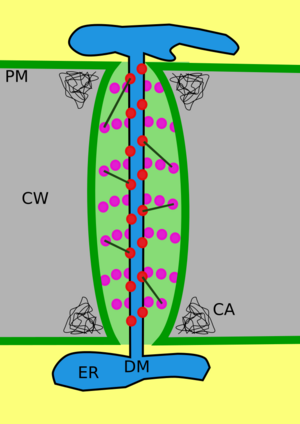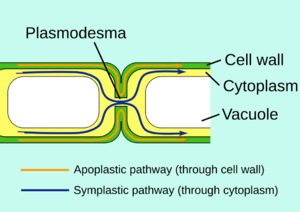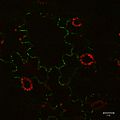Plasmodesma facts for kids

A plasmodesma (say: plaz-moh-DEZ-muh) is a tiny channel that goes through the cell wall of a plant cell. Think of it like a secret tunnel that connects one plant cell to its neighbors! These tunnels allow plant cells to share materials and send messages to each other. Some types of algae also have plasmodesmata.
Unlike animal cells, every plant cell is surrounded by a strong, protective polysaccharide cell wall. This means that neighboring plant cells are separated by two cell walls. Even though cell walls let small molecules pass through, plasmodesmata create a direct, controlled pathway for substances to move between cells.
Contents
What are Plasmodesmata?
Plasmodesmata are like tiny bridges between plant cells. They are very important for how plants grow and stay healthy. Without them, plant cells would be much more isolated.
How do Plant Cells Connect?
Imagine a plant cell as a small room with thick walls. Plasmodesmata are the doorways that connect these rooms. They allow things like water, nutrients, and even signals to pass from one cell to the next. This is much faster and more controlled than if everything had to go all the way around the cell walls.
Why are Plasmodesmata Important for Plants?
These tiny channels are super important for many reasons:
- Sharing Food: They help move sugars (food) made in the leaves to other parts of the plant, like the roots.
- Sending Messages: They allow plant cells to send signals to each other. This helps the plant respond to its environment, like growing towards light.
- Growth and Development: They play a role in how a plant grows and develops, making sure all parts get what they need.
- Defense: They can even help spread defense signals when a plant is attacked by pests.
How are Plasmodesmata Different from Animal Cell Connections?
Animal cells also have ways to connect and communicate, but they are different. For example, Stromules are structures that form between parts of plant cells called plastids. Animal cells don't have cell walls, so their connections are built differently. Plasmodesmata are unique to plants and some algae because of their cell walls.
Images for kids
See also
 In Spanish: Plasmodesmo para niños
In Spanish: Plasmodesmo para niños



